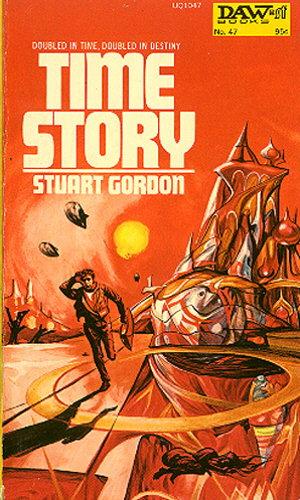

|
| Cover by Josh Kirby |
| TIME STORY Stuart Gordon New York: DAW Books, March 1973 |
Rating: 5.0 High |
|||
| ISBN-13 978-0-879-97047-5 | ||||
| ISBN 0-879-97047-2 | 160p. | SC | $0.95 | |
A car speeding headlong on manual down an automated highway, headlights off. On the passenger seat, the haul from Phil Kitson's first serious caper: fifteen moongems in a radiation-damping bag. Police and military in hot pursuit. He screams off on a side road, ditches the car, runs across open country in the freezing November fog. He goes to ground in wooded patches as copters hover overhead. Suddenly, a deserted farmhouse! He sprints for the well, bag of moongems tucked under his arm. If he can just lower himself one-handed down the rope, out of sight... He almost makes it — but the rope breaks. He plunges down into the slimy frigid water, goes under. It's all that saves him as the copter skims low past the farmhouse, aims its light at the well, but misses him as it drifts to one side. Later, when the pursuers move on, a girl he's never met calls him by name, throws him a rope, tells him to climb up but to leave the bag of moongems in the well. Soon he's in her late-model car, speeding headlong down a twisting country road, headed for his apartment in the city: a temporary refuge...
So begins Stuart Gordon's remarkable saga of time twisted into strange loops, of people impossibly duplicated.
His head fell back to the thin pillow. Hawinda, he thought, if you don't make it, then what the hell happens to me? You're a proud bitch, but you'd bloody well better survive... Now some shadows of what he remembered being told by her drifted in his mind, concerning his own theories about some circle in time. "I think you'll stop existing," she'd said— If he didn't remember. In order to carry out a course of action. Which she said I've already experienced—how many times? His eyes closed. And what if this is not the world she described? – Page 40 |
It's much like The Chronocide Mission1 in some ways. It posits a future 300 years ahead, after an atomic war, when much technology has been lost and more banned by a despotic theocracy. There's an ambitious baron who secretly promotes mind-control and time-travel technology. But Kitson and the girl reach their future by voluntarily booking cold-sleep chambers, not via random time warp. (They had been aiming for a fifty-year slip; the war messed that up. All corporations should build as well as the one that built their sleep chambers and support systems.) The time warp comes later.
The twist, it seems, is that the girl who rescues Kitson from the well is the same one who earlier gave him a lift in an old GT4, then tried to kill him by slamming the car into a wall. She died, he didn't.
Now, in the future, she exists as Hawinda, the girl who joined him in cold sleep, and as Hawisa, a native of that time. One of her must survive to reach the forbidden time machine and jump back to the past, because she already did so. But which one of her will it be? And how can he know which to help, which to oppose?
Kitson was born in 1971. His life of crime began modestly, pulling him away from sculpting, which he was good at but couldn't live on. The moongem caper was to set him up for life. Instead, it nearly sent him away for life when the inside man got nabbed and spilled his guts. Kitson barely missed walking into the trap that their final meeting became. The double was a good likeness, but he spotted him in time; his mannerisms didn't match. Another bit of luck was that Kitson's cruiser was not yet being watched — the benefit of registering it under an alias.
In their future, unable to communicate with each other, Kitson and the girl struggle to devise a way to meet and get to that well. They must contend with a strange culture, at once devout and decadent, in which they start as virtual slaves and work themselves up to positions of some influence. That is the best part of the tale, in my view. But the paradox at its heart is mind-bending, making this a memorable read. I had never encountered Stuart Gordon's work. I'll be looking for more of it.

 To contact Chris Winter, send email to this address.
To contact Chris Winter, send email to this address.